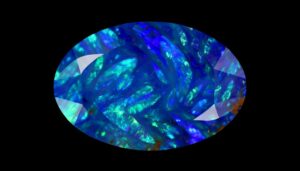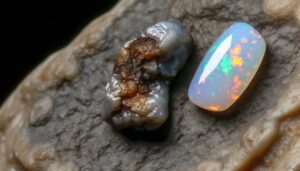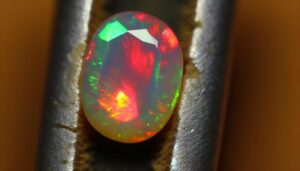What Makes Mexican Fire Opal Unique?
You'll find a Mexican Fire Opal to be a mesmerizing gemstone with colors ranging from fiery reds to serene blues. These opals originate in Mexico's volcanic regions, specifically rhyolitic lava flows.
The vibrant play-of-color stems from hydrated silica spheres that diffract light. With a Mohs hardness of 5.5 to 6.5, they're relatively durable but do absorb water due to their hydrophane nature.
Trace elements like iron impart rich hues and they are often bezel-set in jewelry to highlight their unique optical properties. Discover more about how these elements influence the gem's dazzling array of colors.
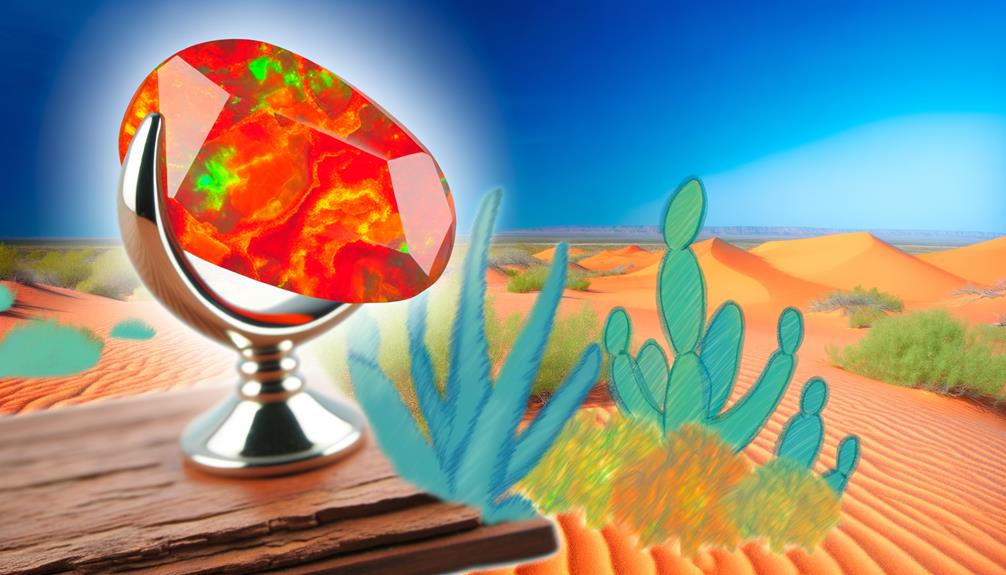
Key Takeaways
- Mexican Fire Opal is a vivid gemstone originating from volcanic regions in Mexico, particularly in Querétaro, Jalisco, and Hidalgo.
- It displays a play-of-color phenomenon with a spectrum of colors, including reds, oranges, and blues.
- These opals form from silica-rich waters depositing hydrated silica spheres in rhyolitic lava flows.
- With a Mohs hardness of 5.5 to 6.5, Mexican Fire Opals are relatively durable yet hydrophane, meaning they can absorb water.
- They are highly valued in jewelry for their vibrant hues and are often bezel-set to protect their relatively softer structure.
Origin and History
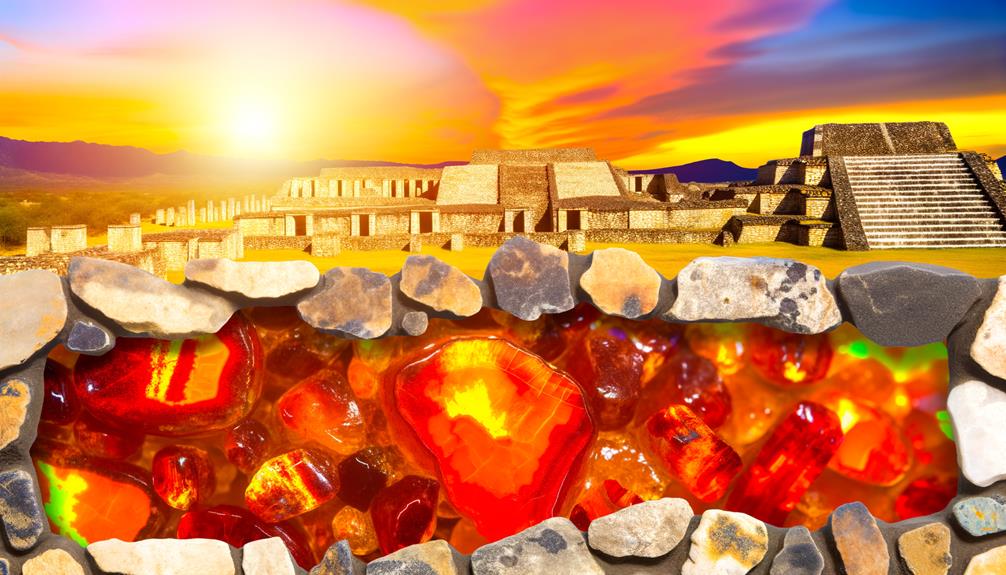
The Mexican Fire Opal, known for its vivid play-of-color, originates primarily from volcanic regions in Mexico, where hydrothermal processes have contributed to its unique formation over millions of years.
You'll find that these opals form in rhyolitic lava flows. Silica-rich waters percolate through the rock, depositing layers of hydrated silica spheres. These spheres diffract light, creating the opal's signature iridescence.
The volcanic activity provides the necessary geothermal gradients and pressure conditions for this mineralization process. Over time, tectonic movements and erosion expose these deposits.
The most significant mining areas include Querétaro, Jalisco, and Hidalgo. Understanding the geologic formation helps appreciate the opal's rarity and the complexity involved in its natural synthesis, emphasizing its geological and gemological significance.
Unique Characteristics
Mexican Fire Opals exhibit a remarkable play-of-color phenomena due to the diffraction of light through their microscopically arranged silica spheres. This unique optical effect is a defining characteristic that sets these opals apart from others.
You'll be fascinated by how these properties manifest:
- Color Spectrum: They can display a wide range of hues, from vivid reds and oranges to subtle greens and blues.
- Transparency: Unlike many opals, Mexican Fire Opals often have a high degree of transparency, enhancing their visual appeal.
- Hardness: With a Mohs hardness of 5.5 to 6.5, they're relatively durable but require careful handling.
- Hydrophane Nature: These opals can absorb water, temporarily changing their color and transparency.
Formation Process
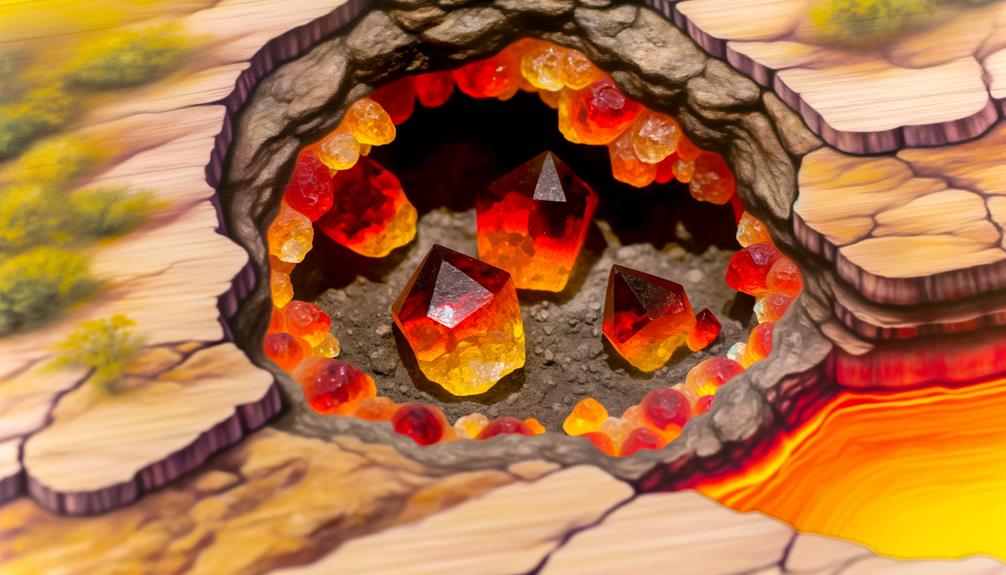
Understanding the unique characteristics of Mexican Fire Opals provides a foundation to appreciate the intricate geological processes that form these stunning gemstones.
Fire opals emerge from volcanic activity, specifically within rhyolitic lava flows. As silica-rich water percolates through the volcanic rock, it deposits microscopic silica spheres in cavities and fissures. Over time, these spheres aggregate, forming a gel-like substance that eventually solidifies into opal. The volcanic environment's high temperatures and pressures facilitate this process.
The presence of trace elements like iron and magnesium influences the opal's final appearance. Additionally, the rapid cooling of lava helps in preserving the opal's internal structure, contributing to its unique play of color and transparency.
This remarkable formation process results in the vibrant allure of Mexican Fire Opals.
Color Variations
Color variations in Mexican Fire Opals arise from the unique interplay of trace elements, structural impurities, and the diffraction of light within the opal's internal microstructure. The presence of iron oxides often imparts hues ranging from yellow to deep red. Meanwhile, the inclusion of water molecules can affect transparency and brightness.
These variations manifest mainly through:
- Iron Content: Higher levels of iron yield more vibrant red and orange tones.
- Hydration Levels: Greater water content enhances translucency.
- Microcrystalline Structure: Variations in silica spheres influence the diffraction of light, creating opalescence.
- Trace Elements: Minor amounts of other elements, such as manganese, can introduce additional colors.
Understanding these factors helps you appreciate the diverse and alluring palette of Mexican Fire Opals.
Uses in Jewelry

Due to their vibrant hues and unique optical properties, Mexican Fire Opals are highly prized in jewelry design, often set in rings, pendants, and earrings to showcase their fiery brilliance.
These opals exhibit a phenomenon known as play-of-color, where diffracted light produces spectral colors. This occurs due to the diffraction of light through submicroscopic silica spheres within the opal's structure.
Jewelers often bezel-set these opals to protect their relatively low Mohs hardness of 5.5-6.5. You'll find that the cabochon cut, which enhances the stone's color play, is preferred.
The gem's translucency varies, influencing its market value. Its vivid orange to red tones make it a focal point in high-end custom jewelry, emphasizing both the gem's natural beauty and inherent fragility.
Care and Maintenance
Proper care and maintenance of Mexican Fire Opals are vital to preserving their vivid hues and structural integrity. These unique gemstones are hydrophane, meaning they can absorb water and other liquids, potentially altering their appearance and durability. To guarantee longevity, adhere to the following guidelines:
- Avoid Prolonged Water Exposure: Limit contact with water to prevent absorption, which can cause cracks or color changes.
- Store in Controlled Environments: Utilize a soft cloth bag or jewelry box to protect from scratches and environmental fluctuations.
- Regular Cleaning: Use a soft, damp cloth; avoid harsh chemicals that can harm the opal's surface.
- Professional Inspections: Periodically consult a gemologist to assess and maintain the stone's integrity.
Follow these steps to maintain your Mexican Fire Opal's luster and stability.
Conclusion
Imagine holding a sunset in your hand; that's the charm of a Mexican fire opal. Just as ancient civilizations revered these gems for their fiery glow, modern enthusiasts treasure them for their unique optical properties.
With proper care, your Mexican fire opal can remain as enchanting as the day it was formed. Like a sunset, it's a fleeting yet eternal moment of beauty, captured in the precise lattice structure of silica and water.



